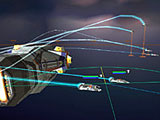 Riding
high on the recent success of strategy titles such as Lords of Magic and Caesar III,
Sierra’s strategy arm, Impressions, makes a foray into the 3D space simulation with
Homeworld. As much an adventure game as an RTS game, Homeworld puts players in charge of
leading the Kharakid people back to their original home on the other side of the galaxy.
The game unfolds in a series of missions that tell the story of the Kharakid’s
journey and the events they encounter.
Riding
high on the recent success of strategy titles such as Lords of Magic and Caesar III,
Sierra’s strategy arm, Impressions, makes a foray into the 3D space simulation with
Homeworld. As much an adventure game as an RTS game, Homeworld puts players in charge of
leading the Kharakid people back to their original home on the other side of the galaxy.
The game unfolds in a series of missions that tell the story of the Kharakid’s
journey and the events they encounter. 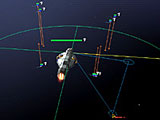 Sierra bills Homeworld as a 3D RTS game, and it is, up to a point. Throughout
the various missions, players must build up their fleet of ships, collect resources,
research new technologies, and defend their mothership from attacks. Many standard RTS
elements are present, including a completely variable viewpoint that can be rotated and
zoomed to any point on the map, the ability to assign ships to groups, and various
formations and attack orders. In the single player campaign, however, the story is tightly
interwoven into the missions, with frequent pauses in the action as video sequences play
out. This tight integration gives Homeworld a definite adventure game feel, even more so
than games like Starcraft. Fortunately, in the case of Homeworld, this mix of strategy and
adventure works well, creating an engrossing and fun experience at the expense of lowering
replay value.
Sierra bills Homeworld as a 3D RTS game, and it is, up to a point. Throughout
the various missions, players must build up their fleet of ships, collect resources,
research new technologies, and defend their mothership from attacks. Many standard RTS
elements are present, including a completely variable viewpoint that can be rotated and
zoomed to any point on the map, the ability to assign ships to groups, and various
formations and attack orders. In the single player campaign, however, the story is tightly
interwoven into the missions, with frequent pauses in the action as video sequences play
out. This tight integration gives Homeworld a definite adventure game feel, even more so
than games like Starcraft. Fortunately, in the case of Homeworld, this mix of strategy and
adventure works well, creating an engrossing and fun experience at the expense of lowering
replay value.
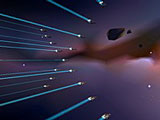 Graphically, Homeworld is quite
attractive. The ships are finely detailed, but the best part is the ability to zoom in on
a single ship in real time and rotate the camera angle in any direction with no slowdown
in gameplay. Damaged ships show fragments and explosions as they approach destruction. For
larger ships, like the mothership, players can follow ships all the way inside the docking
bay, quite a nice touch of detail. Backgrounds are beautiful, with dust clouds, planets
and stars all rendered beautifully. The only disappointment is relative weakness of weapon
effects, which seem a bit plain by comparison. The audio is also well done, with good
sound effects and background music that doesn’t distract from gameplay.
Graphically, Homeworld is quite
attractive. The ships are finely detailed, but the best part is the ability to zoom in on
a single ship in real time and rotate the camera angle in any direction with no slowdown
in gameplay. Damaged ships show fragments and explosions as they approach destruction. For
larger ships, like the mothership, players can follow ships all the way inside the docking
bay, quite a nice touch of detail. Backgrounds are beautiful, with dust clouds, planets
and stars all rendered beautifully. The only disappointment is relative weakness of weapon
effects, which seem a bit plain by comparison. The audio is also well done, with good
sound effects and background music that doesn’t distract from gameplay.
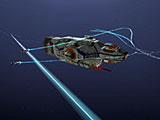 From a tactical point of view,
Homeworld seems a bit weak at first, but as the campaign develops and new ship types
become available, the options expand quickly. It’s a good thing, too, because the
game gets difficult fast. Players shouldn’t be surprised if they are forced to replay
several missions, trying different tactics before achieving victory. One of the most
frustrating things, however, is actually completing a mission, but having to replay it
because the loss of a key ship (such as a resource collector) will prevent success in
future missions. Also, the Kharakid mothership seems woefully under-armed compared to
those of other races in the galaxy. Watching the mothership being sliced to pieces by an
enemy mothership armed with ion beam weapons is quite frustrating. Using salvage ships to
capture enemy capital ships, however, is a great feeling.
From a tactical point of view,
Homeworld seems a bit weak at first, but as the campaign develops and new ship types
become available, the options expand quickly. It’s a good thing, too, because the
game gets difficult fast. Players shouldn’t be surprised if they are forced to replay
several missions, trying different tactics before achieving victory. One of the most
frustrating things, however, is actually completing a mission, but having to replay it
because the loss of a key ship (such as a resource collector) will prevent success in
future missions. Also, the Kharakid mothership seems woefully under-armed compared to
those of other races in the galaxy. Watching the mothership being sliced to pieces by an
enemy mothership armed with ion beam weapons is quite frustrating. Using salvage ships to
capture enemy capital ships, however, is a great feeling.
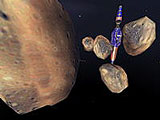 The interface is well done, and
Homeworld is one of the first games to make good use of a mouse with a scroll wheel or
button, placing the zoom control there. This layout makes it easy to zoom in and out while
rotating the view. Keyboard shortcuts exist for most commands, and some are exclusive,
such as assigning and selecting task groups. The manual explains the commands quite well,
but it takes a bit of practice to get the hang of it. Fortunately, the tutorials are
excellent and really serve to teach players the basics of movement and combat.
The interface is well done, and
Homeworld is one of the first games to make good use of a mouse with a scroll wheel or
button, placing the zoom control there. This layout makes it easy to zoom in and out while
rotating the view. Keyboard shortcuts exist for most commands, and some are exclusive,
such as assigning and selecting task groups. The manual explains the commands quite well,
but it takes a bit of practice to get the hang of it. Fortunately, the tutorials are
excellent and really serve to teach players the basics of movement and combat.
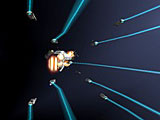 Homeworld does have a few weak
spots, however. While the manual makes a good reference for controls, systems and
technologies, the layout is horrible, forcing players to search through page after page
for specific information. Sections are even printed sideways, making it even harder to use
as a reference. The background story is interesting and fun to read, but even this story
is retold in the game’s introduction. While multiplayer support is present, the game
just doesn’t lend itself to multiplayer action as well as other RTS games. The
strength of the single player story seems to detract from the multiplayer experience,
making it seem a bit dull by comparison. There are three main problems with the single
player game. First, the video sequences used to tell the story detract from the action,
inserting pauses while the story unfolds. This can be distracting when it happens in the
middle of a battle, as some of the sequences are quite long. Second, it is imperative to
collect all possible resources in each mission, but often this is only possible after all
mission objectives have been achieved, making for long amounts of dead space between
missions while the resource collectors do their work. The only good thing about this is
that it gives time to perform research and rebuild the fleet before entering hyperspace
and proceeding to the next mission. Finally, the biggest problem is that once the campaign
has been completed, there is little replay value left. Although the game can be played
from two different perspectives, it seems to flow almost identically from each one. Also,
the campaign is relatively short (16 missions), providing less gameplay than most other
RTS titles.
Homeworld does have a few weak
spots, however. While the manual makes a good reference for controls, systems and
technologies, the layout is horrible, forcing players to search through page after page
for specific information. Sections are even printed sideways, making it even harder to use
as a reference. The background story is interesting and fun to read, but even this story
is retold in the game’s introduction. While multiplayer support is present, the game
just doesn’t lend itself to multiplayer action as well as other RTS games. The
strength of the single player story seems to detract from the multiplayer experience,
making it seem a bit dull by comparison. There are three main problems with the single
player game. First, the video sequences used to tell the story detract from the action,
inserting pauses while the story unfolds. This can be distracting when it happens in the
middle of a battle, as some of the sequences are quite long. Second, it is imperative to
collect all possible resources in each mission, but often this is only possible after all
mission objectives have been achieved, making for long amounts of dead space between
missions while the resource collectors do their work. The only good thing about this is
that it gives time to perform research and rebuild the fleet before entering hyperspace
and proceeding to the next mission. Finally, the biggest problem is that once the campaign
has been completed, there is little replay value left. Although the game can be played
from two different perspectives, it seems to flow almost identically from each one. Also,
the campaign is relatively short (16 missions), providing less gameplay than most other
RTS titles.
Overall, Homeworld is a well-done game that should provide a good gaming experience for
veterans of other RTS games. Gamers looking for something a bit different or an RTS game
with a strong story should definitely give this game a try.
--Derek Meyer

 Riding
high on the recent success of strategy titles such as Lords of Magic and Caesar III,
Sierra’s strategy arm, Impressions, makes a foray into the 3D space simulation with
Homeworld. As much an adventure game as an RTS game, Homeworld puts players in charge of
leading the Kharakid people back to their original home on the other side of the galaxy.
The game unfolds in a series of missions that tell the story of the Kharakid’s
journey and the events they encounter.
Riding
high on the recent success of strategy titles such as Lords of Magic and Caesar III,
Sierra’s strategy arm, Impressions, makes a foray into the 3D space simulation with
Homeworld. As much an adventure game as an RTS game, Homeworld puts players in charge of
leading the Kharakid people back to their original home on the other side of the galaxy.
The game unfolds in a series of missions that tell the story of the Kharakid’s
journey and the events they encounter.